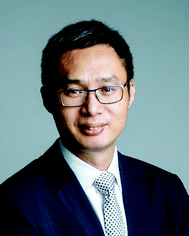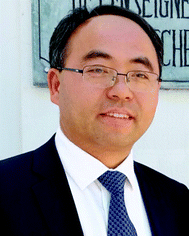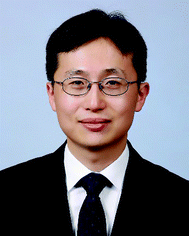Materials chemistry in flexible electronics
Xiaodong
Chen
a,
John A.
Rogers
bcd,
Stéphanie P.
Lacour
e,
Wenping
Hu
f and
Dae-Hyeong
Kim
gh
aInnovative Centre for Flexible Devices (iFLEX), School of Materials Science and Engineering, Nanyang Technological University, 50 Nanyang Avenue, 639798, Singapore. E-mail: chenxd@ntu.edu.sg
bDepartment of Materials Science and Engineering, Northwestern University, Evanston, Illinois 60208, USA
cCenter for Bio-Integrated Electronics, Northwestern University, Evanston, Illinois 60208, USA
dDepartments of Biomedical Engineering, Neurological Surgery, Chemistry, Mechanical Engineering, Electrical Engineering, and Computer Science, Simpson Querrey Institute for Nano/Biotechnology, Northwestern University, Evanston, Illinois 60208, USA. E-mail: jrogers@northwestern.edu
eBertarelli Foundation Chair in Neuroprosthetic Technology, Laboratory for Soft Bioelectronic Interfaces, Institute of Microengineering, Institute of Bioengineering, Centre for Neuroprosthetics, École Polytechnique Fédérale de Lausanne (EPFL), 1202 Geneva, Switzerland. E-mail: stephanie.lacour@epfl.ch
fTianjin Key Laboratory of Molecular Optoelectronic Science, Department of Chemistry, School of Science, Tianjin University & Collaborative Innovation Center of Chemical Science and Engineering (Tianjin), Tianjin 300072, China. E-mail: huwp@tju.edu.cn
gCenter for Nanoparticle Research, Institute for Basic Science (IBS), Seoul 08826, Republic of Korea
hInstitute of Chemical Processing (ICP), Seoul National University, Seoul 08826, Republic of Korea. E-mail: dkim98@snu.ac.kr
Why this themed issue
Electronic components are going to be fully portable, wearable, and even implantable soon for the purposes of smart life assistance, rehabilitation, and even human enhancement. Chemists and materials scientists are proposing and developing new materials and fabrication strategies to achieve the final goal of fully bio-integrated electronics. These technological innovations in materials, processes, and device design could give rise to a dramatic improvement in the performance of wearable and implantable electronics.The combination of soft materials and active electronic materials to achieve high flexibility and stretchability of electronic devices has been extensively explored in the past two decades. Materials chemistry played key roles in this exploration, including developing new active materials, new soft elastic substrates, and new integration processes of both. Traditional active materials, like silicon, gold, silver, carbon, and so on, have been repurposed through novel structural designs and integration processes. New organic-based electronic components and elastic substrates have also been developed. Although the mobility, conductivity, and stability of these organic materials are waiting to be optimized, this opens many new opportunities toward the next generation of bio-integrated electronics. Also, new soft elastic substrates are becoming abundant and multi-functional with new supramolecules, polymers, hydrogels, and other biomaterials based on the latest genetic and synthetic biology technologies. These branches are growing very fast, and it is time to review and analyse all these efforts, sum up the first stage, and draw the next blueprint.
To showcase recent advances in this emerging field, this themed issue wraps up the recent efforts in the important flexible and stretchable materials and electronics areas and focuses on the challenges remaining to point out future research directions. The issue brings together contributions from leading experts and covers the following three critical aspects of materials chemistry in flexible electronics.
(1) Processing materials for high performance flexible electronics
To achieve high-performance flexible and stretchable electronics, organic materials and nanoscale materials are regarded as great candidates for such devices due to their ease of processing and excellent flexibility. Three reviews are dedicated to elucidating how materials have been processed for high performance flexible electronics. Significant progress in utilizing nanomaterials to achieve high-performance stretchable conductive nanocomposites for soft electronics, optoelectronics, and energy harvesting devices is reviewed by Kim et al. (DOI: 10.1039/C8CS00706C). How conductive nanomaterials can be integrated with inkjet-based manufacturing processes is also a key to facilitating the translation between research results and industrial application of flexible electronics, which is summarized by Magdassi et al. (DOI: 10.1039/C8CS00738A). Colloidal nanocrystals of bulk group IV, III–V, II–VI, IV–VI, I–III–VI2 and metal–halide perovskite semiconductors are excellent for thin film and flexible electronics. Kagan (DOI: 10.1039/C8CS00629F) summarizes how to precisely control the synthesis and assembly of semiconducting nanocrystals for flexible electronic devices.Three reviews are involved in elaborating on the application of organic materials in flexible electronics. The progress and challenges of organic crystalline materials and their processing technologies for flexible transistors and resistive switching device applications are summarized by Hu et al. (DOI: 10.1039/C8CS00406D) and Li et al. (DOI: 10.1039/C8CS00614H). And how to design non-fullerene electron acceptors for organic solar cells is reviewed in-depth by Wadsworth et al. (DOI: 10.1039/C7CS00892A). Besides, Stadlober et al. (DOI: 10.1039/C8CS00928G) summarize the integration of ferroelectric polymers in flexible electronics for smart sensor applications.
(2) Unusual mechanical properties of electronic materials and devices
In addition to the processing of active materials, obtaining the desired mechanical properties of flexible devices is an important focus for flexible device research to sustain compliance with the dynamic environments where the devices operate. A commonly adopted method is to integrate active materials with soft materials such as silicone elastomers and hydrogels. A tutorial review by Skov et al. (DOI: 10.1039/C8CS00963E) concludes how to tailor the composition of silicone elastomers to achieve desired mechanical and chemical properties in soft electronics applications. Further, Zhao et al. (DOI: 10.1039/C8CS00595H) provide a review on how to realize hydrogel bioelectronics by discussing the mechanism of tissue–electrode interactions and the uniqueness and rational guidelines of hydrogels in bioelectronics. Not only soft and flexible substrates have been surveyed, active materials and flexible substrates need to be engineered and integrated strategically. Cheng et al. (DOI: 10.1039/C8CS00609A) summarize how to soften gold through materials chemistry for stretchable electronics. And Pei et al. (DOI: 10.1039/C8CS00834E) have surveyed morphological/nanostructural controls for intrinsically stretchable organic electronics to obtain both mechanical flexibility and electrical properties.From materials to devices, the assembly of multiple materials and device units always requires delicate design. Both molecular design and mechanical design for active materials and integrated devices to proactively modulate mechanical properties of mechano-adaptable devices are reviewed by Chen et al. (DOI: 10.1039/C8CS00801A). This great progress has undoubtedly promoted the field of flexible electronics towards the application of wearable and implantable devices.
(3) Wearable and implantable applications of flexible electronics
Next-generation wearable devices should be beneficial toward personalized medicine to provide predictive analytics and treatment. Gao et al. (DOI: 10.1039/C7CS00730B) sum up the mechanisms and recent progress in molecular analysis in sweat, tears, saliva, blood, etc. for wearable biosensors. Research towards single-platform, cost-effective, portable and fully-functional systems would definitely continue progress towards realizing continuous personalized health monitoring. Furthermore, implantable devices for neural interfaces have produced further refinement in the spatiotemporal resolution, cell-type selectivity, and long-term stability of neural interfaces. To conform with these issues, fiber-based neural probes were developed and Anikeeva et al. (DOI: 10.1039/C8CS00710A) review how fiber-based probes work in the emerging studies of nerve growth and repair.Final remarks
We do hope the readers enjoy the materials chemistry in flexible electronics issue presented here, and find it inspiring for their future research with blooming ideas and progress to further usher the prosperity of this field. This research is absolutely multi-disciplinary, and the related chemical, electrical, and biomedical investigations are closely involved each other. Near the end, we would like to express our sincere appreciation to all the authors for their fabulous contributions to this themed issue. With the issue containing these excellent review articles, we believe researchers in various fields will get a broader and deeper understanding of flexible electronics. We do hope to witness more exciting research milestones in this area in the future. Finally, we would like to thank all the editorial staff members of Chemical Society Reviews for their strong support.| This journal is © The Royal Society of Chemistry 2019 |





